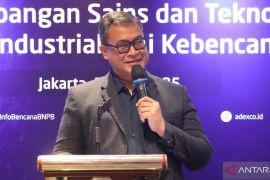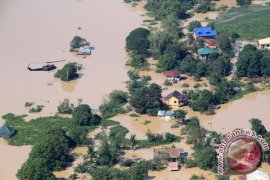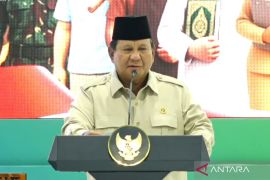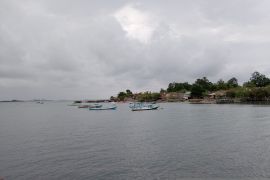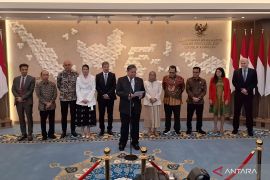The risk is growing around the world. We are facing unprecedented hazards that are accumulating on top of those that we already have in the pastBadung, Bali (ANTARA) - Over two years since the COVID-19 pandemic began, the world has profoundly changed, as have the opportunities for social, infrastructural, and economic recovery.
The impacts of the pandemic have been compounded by other natural disasters, conflicts, and crises.
Disasters, such as the COVID-19 pandemic, undermine development gains and set back efforts to achieve the Sustainable Development Goals (SDGs).
The United Nations Office for Disaster Risk Reduction (UNDRR) assessed that disaster risk has increased worldwide, and the world faces an unusual threat of disaster risk.
"The risk is growing around the world. We are facing unprecedented hazards that are accumulating on top of those that we already have in the past," UNDRR Director Ricardo Mena noted in a special interview with ANTARA here on Monday (May 23).
"The COVID-19 (pandemic) is a clear example of what I mean (by increasing disaster risk) and also an emergency that is changing the (disaster) risk landscape," he stated.
Considering such a condition, Mena emphasized the importance for countries around the world to continue to work together to mitigate disasters and reduce disaster risk. More importantly, he stressed, all countries should become involved in the global effort to reduce disaster risks.
Related news: Indonesia's preparations for GPDRR 90% complete: minister
"I think it is a global effort since disaster has no borders. Governments need to work very closely with all stakeholders because no one alone can resolve the challenges that disaster risks brought in front of us," Mena remarked.
"Hence, we need concerted approach between the governments and between key stakeholders and the society, as well as private sectors and the academia ... all of those need to play the role in disaster risk reduction," he emphasized.
It was for this joint effort between countries that the Global Platform for Disaster Risk Reduction (GPDRR) was formed. The platform is an international forum to discuss the Sendai Framework for disaster risk reduction, also known as the Sendai Framework 2015-2030.
The Sendai Framework, which was ratified by 187 countries, aims to become a global work reference in reducing various disaster risks around the world in future.
From Risk to Resilience
Furthermore, Ricardo Mena noted that the 7th Session of the GPDRR held in Bali this year aimed at carrying a message that invites the world to move forward from disaster risk to disaster resilience.
"This is where the GPDRR as a platform is trying to bring forth the message of moving forward from risk to resilience," he stated.
"If we have to continue on the path that we are now on, we won't be able to meet the SDGs, and for that, we have to move to make some preventive approach that moves us from risk to resilience," he added.
Related news: 2022 GPDRR features three major disaster risk meetings
He further called for unified efforts from countries to move from a state of risk to disaster resilience.
According to the UNDRR Director, the first crucial step is for each country's government to know all disaster risks faced in their country.
"The first thing that needs to be done is to understand the kind of disaster risks they are facing. This is an important key starting point," Mena stated.
"If you do not know what your risks landscape looks like, then it is going to be really difficult for you to set some priorities for disaster risk reduction," he explained.
Hence, he encourages the central and local governments to evaluate disaster risk in their countries and develop initiatives and several measures or tools that can be used to identify areas that need to be strengthened to build disaster resilience.
Mena stressed that measures to build resilience and reduce disaster risk should also take into account all adaptation measures to climate change.
"We have seen in the past decade, the number of disasters that have brought high impacts are related to the hydrometeorological phenomena, and many of them are being exacerbated by climate change," he pointed out.
"Hence, we need to put more emphasis on climate change adaptation and its linkages with disaster risk reduction," he remarked.
According to Mena, apart from understanding the existing risks, increasing investment in disaster risk reduction efforts is also crucial to build resilience.
"If we really want to achieve resilience, we need to increase investment in disaster risk reduction (DRR). Hence, we need more funding being allocated to the DRR efforts," he stressed.
"We also need to ensure that the commitment by governments to increase funding for climate adaptation at the Glasgow COP26 are indeed materialized, so that countries can invest more to reduce disaster risks related to climate change," he affirmed.
One of the concrete investments in disaster risk reduction efforts is in the form of additional financing to ensure that all measures can be applied.
Related news: Disaster mitigation derived from local wisdom
"This does not necessarily mean there needs to be more resources, although that is quite welcomed but it is also about the way you use every resource you have to ensure that resilience elements are incorporated into the use of those resources, so that your risks become lower," he explained.
For instance, countries need to get stronger in nurturing all the infrastructure that is being built in compliance with the basic standards to make it more resilient
"We have seen in the past how many schools, hospitals, and airports, and so many infrastructures have been completely destroyed by disasters and this is because the norms, codes, and the financing of infrastructure need to be revisited. Hence, we really need to move to a preventive focus and that is urgent," Mena stated.
He emphasized that another important aspect in building resilience is the participation of local governments and civil society.
"Municipalities have to do all these consultations with the people, in particular, those who are most affected by the impact of the disaster. Hence, this is another important element. It has to be the engagement of the whole society and the governance of risks should be better at the local as well as national level," Mena stated.
Resilient World
The 7th session of GPDRR was held this year in conjunction with the 5th World Reconstruction Conference (WRC5), which according to UNDP, aims to create a momentum to build a more resilient world to recover from the crisis.
Several countries have proven to be able to control the pandemic and emerge from the crisis, so that such a success can be an inspiration for other countries to strengthen resilience in their respective regions, Director of the Crisis Bureau of the United Nations Development Program (UNDP) Asako Okai stated at the opening of WRC-5 in Bali on Monday.
"For UNDP, this meeting is an important input for our commitment to building a resilient world," Okai stated.
She noted that post-disaster recovery, including recovery from the COVID-19 pandemic, can be an opportunity to reorganize development and build world resilience.
"Post-disaster recovery is an opportunity to reset the development pathway toward a greener and more resilient future," according to Okai, who is concurrently the UN Assistant Secretary General.
She remarked that the next task for WRC participating countries is to unite their respective experiences and policies into some concrete global actions.
"A greener, more resilient, and inclusive approach to recovery will help repair the structural damage caused by COVID-19 and accelerate climate change mitigation and adaptation efforts while restoring momentum on poverty reduction and shared prosperity," Okai concluded.
Related news: GPDRR should devise solutions for climate change issues: KSP chief
Related news: Indonesia leading on global efforts reducing disaster risks: UNDRR
Editor: Fardah Assegaf
Copyright © ANTARA 2022

